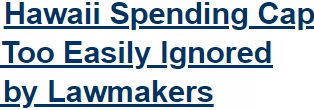Two days ago, I explained that spending caps are better than anti-deficit rules. In this clip from the same panel discussion, I talk about how a spending cap should be designed.
The key design issue is how fast spending should increase.
For libertarians and Reaganite conservatives, the goal is to shrink the burden of government. This means a cap that fulfills my Golden Rule of having government grow slower than the private sector.
So if long-run nominal GDP is projected to grow by, say, 5 percent per year, the cap might allow government to grow 2 percent or 3 percent annually.
That’s somewhat like the TABOR rule in Colorado, which limits government to grow no faster than inflation plus population.
For more moderate types, the goal might be to maintain the status quo.
In other words, don’t attempt to shrink government, but also don’t allow government to expand.
Perhaps that would mean a spending cap tied to nominal personal income growth, which might mean allowing spending to grow 4 percent or 5 percent each year.
That sound anemic, but it is definitely better than nothing since it would force lawmakers to somehow prevent the huge future spending increases that will be caused by America’s poorly designed entitlement programs.
But then there’s the issue of how a spending cap gets enforced.
I was cited in a 2020 article about this challenge in Hawaii.
Hawaii’s existing cap is too easily ignored by lawmakers. …So what would a “spending cap with teeth” look like? Mitchell said there are many types of spending caps that could be adopted. Hawaii added a spending cap to its Constitution in 1978, but it was essentially arbitrary due to an escape clause that allows the Legislature to override the cap with a two-thirds vote. “That escape clause, especially in a state where one party dominates the government, basically means that your spending cap isn’t very effective at all,” said Mitchell. So what would be better? Mitchell is especially fond of the spending cap that Colorado voters adopted in 1992, which Colorado’s Department of the Treasury estimated in 2019 had returned more than $2 billion to state taxpayers since it was implemented. Called the Taxpayer’s Bill of Rights Amendment, it pegs state spending to population growth plus inflation. Colorado’s legislature can still propose a budget that exceeds the spending cap, but “the politicians have to go to the voters and ask for permission, and the voters in almost all cases say no.”
The bottom line is that spending caps are like speed limits in a school zone.
With small children present, the best speed limit might be 20 miles per hour.
By contrast, a speed limit of 45 miles per hour seems unwise. Then again, it would be better than nothing.
And we can’t forget that any speed limit won’t be worth much if there’s no enforcement.
I’ll close by sharing this table, which shows various nations that got very good results with multi-year periods of spending restraint (government growing, on average, by less than 2 percent annually).

P.S. The advantage of a numerical spending cap (such as limiting spending increases to no more than 2 percent annually) is that politicians would have a big incentive to keep inflation under control (meaning Biden’s economic team would not have allowed him to make vapid remarks about inflation during his state of the union address).
———
Image credit: Trevor205 | Pixabay License.



